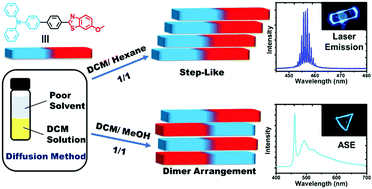Organic polymorphs with tunable luminescence are crucial in developing organic luminescent materials, but the regulation of molecular packing modes and intermolecular interactions in organic crystals remains a challenge. Here, we report three triphenylamine–benzothiazole (TZ) compounds by systematically changing the substituents, resulting in different crystal emission characteristics. The polymorphs of blue emission (TZ-1B) and cyan emission (TZ-1C) crystals are obtained by controlling the crystallization conditions, however, we could not obtain organic polymorphs of TZ-2 or TZ-3 in various solvent systems. By molecular systems and detailed single crystal analysis, it is found that appropriate substituents play a key role in manipulating the intermolecular interactions and the molecular packing modes to affect the optical properties of organic crystals. Moreover, TZ-1C exhibits blue-shifted mechanochromism, while TZ-1B does not. More importantly, TZ-1B exhibits a lasing emission at 454 nm with a low threshold and a high cavity quality factor. TZ-1C exhibits amplified spontaneous emission (ASE) at 462 nm. Thus, the molecular systems provide a reasonably potent molecular strategy to understand the molecular packing structure–fluorescence property relationship.

